


F-35
Joint Strike Fighter (JSF)
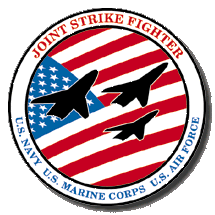
The F-35 is the result of the Defense Department's Joint Strike Fighter (JSF) program, which sought to build a multirole fighter optimized for the air-to-ground role with secondary air-to-air capability. The JSF requirement was to meet the needs of the Air Force, Navy, Marine Corps and allies, with improved survivability, precision engagement capability, and reduced life cycle costs. By using many of the same technologies developed for the F-22, the F-35 has the opportunity to capitalize on commonality and modularity to maximize affordability.
The Lockheed Martin X-35 was chosen over the competing Boeing X-32 primarily because of Lockheed’s lift-fan STOVL design, which proved superior to the Boeing vectored-thrust approach. The lift fan, which is powered by the aircraft engine via a clutched driveshaft, was technically challenging but DoD concluded that Lockheed has the technology in hand. The lift fan has significant excess power which could be critical given the weight gain that all fighter aircraft experience.
Lockheed Martin developed four versions of the Joint Strike Fighter to fulfill the needs of the Navy, Marine Corps, Army, Air Force and the United Kingdom Royal Air Force and Navy. All versions have the same fuselage and internal weapons bay, common outer mold lines with similar structural geometries, identical wing sweeps, and comparable tail shapes. The weapons are stored in two parallel bays located aft of the main landing gear. The canopy, radar, ejection system, subsystems, and avionics are all common among all different version as is the core engine which is based on the F119 by Pratt & Whitney.
Additional systems on the F-35 include:
- Northrup Grumman advanced electronically scanned array (AESA) multi-function radar
- Snader/Litton Amecon electronic countermeasures equipment
- Lockheed Martin electro-optical targeting system
- Northrup Grumman distributed aperture infrared sensor (DAIRS) thermal imaging system
- Vision Systems International advanced helmet-mounted display
F-35 Variants
US Air Force
The Air Force expects that to purchase 1763 F-35s to complement the F-22 Raptor and replace the F-16 as an air-toground strike aircraft. The Air Force variant includes an internal gun, infrared sensors, and laser designator. This is the technologically simplest version of the JSF, in that it does not require hover or aircraft carrier capability. Therefore it does not require the vertical thrust or the handling qualities for catapult launches, augmented control authority at landing approach speeds and strengthened structure to handle arrested landings. At the same time, the Air Force F-35 will have to improve upon the high standards created by the F-16. Since replacement of the F-16 by the F-35 will entail a significant payload reduction, the F-35 faces a very demanding one shot one kill requirement.
US Navy
The requirement for carrier operations creates the largest differences between the Air Force and Navy version. The naval version has larger wing and tail control surfaces to enable low-speed approaches to aircraft carriers. Leadingedge flaps and foldable wing tip sections account for this increased wing area. The larger wing area also provides the Navy version with an increased payload capability. To support the stresses of carrier landings and catapult launches, the internal structure of this version is strengthened. In addition, the landing gear has longer stroke and higher load capacity, and of course an arresting hook is added. Compared to the F-18C, the F-35 has twice the range on internal fuel.. The design is also optimized for survivability, which is a key Navy requirement. Like the USAF version, the Navy version will incorporate an internal gun and sensors. This new fighter will be used by the Navy as a first-day-of-war attack fighter in conjunction with the F/A-18 Hornet. The Navy plans to purchase 480 JSF.
US Marine Corps
The distinguishing feature of the USMC version of the JSF is its short takeoff/vertical landing capability (STOVL). There will not be an internally mounted machine gun, but an external gun can be fitted. This version requires controllability on all axes while hovering. Another critical design feature is its impact on the ground surface beneath it during hover. The USMC expects their version of the JSF will replace the F/A-18 Hornet and the AV-8 Harrier. The Marine Corps expects to purchase 480 STOVL versions of the F-35.
United Kingdom Royal Navy and Air Force
This version will be very similar to the one procured by the United States Marine Corps
Images
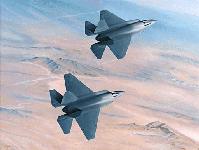
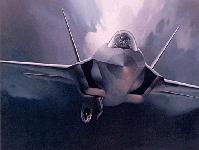
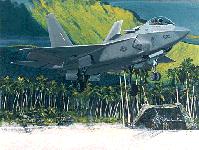

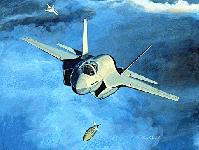
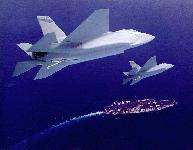
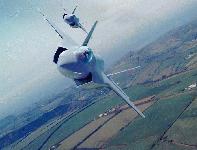
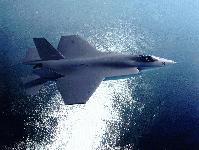
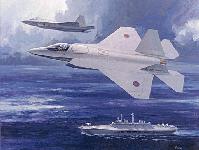
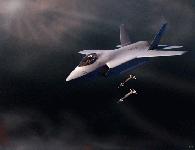
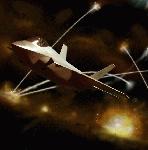
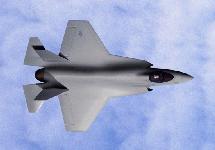
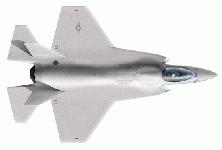
Specifications
|
| Function |
strike fighter
|
| Contractor |
two competing teams:
Lockheed-Martin
Boeing
|
| Service
|
U.S. Air Force
|
U.S. Marine Corps
U.K. Royal Navy
|
U.S. Navy
|
| Variants
|
Conventional Takeoff and Landing (CTOL)
|
Short Takeoff and Vertical Landing (STOVL)
|
Carrier-based (CV)
|
| Unit Cost FY94$
| $28M
| $35M
| $38M
|
| Propulsion
| Baseline: Pratt & Whitney F119-PW-100 derivative from F-22 Raptor
Alternate Engine: General Electric F120 core
|
| Thrust
|
|
|
|
| Empty Weight
| ~22,500 lbs
| ~24,000 lbs
|
| Internal Fuel
| 15,000 lbs
| 16,000 lbs
|
| Payload
| 13,000 lbs
| 17,000 lbs
|
| Maximum Takeoff Weight
| ~50,000 lbs
|
| Length
| 45 feet
|
| Wingspan
| 36 feet
| 30 feet
|
| Height
|
|
|
|
| Ceiling
|
|
|
|
| Speed
| supersonic
|
| Combat Radius
| over 600 nautical miles
|
| Crew
| one
|
| Armament
|
|
|
|
| First flight
| 1999
|
| Date Deployed
| 2008
|
| Inventory Objectives
|
U.S. Air Force
1,763 aircraft
|
U.S. Marine Corps
480 aircraft
U.K. Royal Navy
60 aircraft
|
U.S. Navy
480 aircraft
|
Sources and Resources
- Joint Strike Fighter
- Dave Hasting's JSF Page
- Joint Adv Strike Tech Program FY98 R&D Budget Request
- 0603800N JOINT ADVANCED STRIKE JASTP FY98 R&D Budget Request
- The Joint Strike Fighter Derek W. Avance; Christopher S. Ceplecha; Robert E. Clay; Terry M. Featherston; David S. Grantham; Thomas E. Gregory (Faculty Advisor); Patrick A. Kelleher; David Kelly; Thomas L. Moore (Faculty Advisor); Garry L. Pendleton; John Rupp; Christopher E. Yelder Air Command and Staff College 1996
- JSF excerpts from House National Security Committee Report on House National Defense Authorization Act for FY 1998
- MEMORANDUM FOR CORRESPONDENTS June 23, 1998
The Joint Strike Fighter program office today announced today that Pratt & Whitney began ground testing the second of two developmental engine designs for the Joint Strike Fighter (JSF) Concept Demonstrator Aircraft (CDA).
- Designing The Next Generation Strike Fighter Brigadier General Leslie Kenne, Director, Joint Strike Fighter Program Office [1500k PDF]
- Joint Strike Fighter concept demonstrators slated to begin flying Air Force Print News 24 May 2000 -- Competitors for the Air Force's newest multi-role aircraft, the Joint Strike Fighter, will begin flying their concept demonstrators in the next few months.
- Cohen: Joint Strike Fighter program must stay on schedule, Stars and Stripes, 24 June 2000 -- Defense Secretary William Cohen sent a letter to senior House and Senate lawmakers Thursday urging them to keep the funding and schedule for the Pentagon's Joint Strike Fighter aircraft on schedule.
- First Joint Strike Fighter lands at Edwards, Air Force Print News, 20 September 2000 -- One version of the Joint Strike Fighter program made its first flight early Sept. 18.
- The Lockheed Martin Joint Strike Fighter F-35A successfully executed a series of airborne refuelings during its 10th flight, demonstrating the aircraft's flying qualities during refueling and paving the way for extended test flights., Air Force Print News, 15 November 2000 -- The Lockheed Martin Joint Strike Fighter F-35A successfully executed a series of airborne refuelings during its 10th flight, demonstrating the aircraft's flying qualities during refueling and paving the way for extended test flights.
- F-35A breaks sound barrier, Air Force Print News, 27 November 2000 -- With its flight testing now complete, the F-35A returned to Lockheed Martin's nearby Palmdale, Calif., facility to be fitted with a shaft-driven lift-fan propulsion system. It will be renamed the F-35B and will begin ground testing in preparation for its short takeoff/vertical landing demonstrations.
- Navy Variant of Lockheed Martin JSF Takes Flight, Lockheed Martin Press Release, 16 December 2000 -- The United States Navy version of the Lockheed Martin Joint Strike Fighter (JSF) demonstrator took to the skies on Saturday, Dec. 16, initiating a flight-test program that will focus on carrier-suitable flying qualities and aircraft performance.
- U.S., U.K. Sign Joint Strike Fighter Agreement Jan. 17, U.S. Department of Defense, 17 January 2001 -- Deputy Defense Secretary Rudy de Leon signed a U.S.-United Kingdom Memorandum of Understanding on the joint strike fighter (JSF) with Baroness Symons of Vernham Dean, U.K. Minister of State for Defence Procurement, in a ceremony at the Pentagon January 17.
- U.S., UK Defense Officials on Joint Strike Fighter Jet, U.S. Department of Defense, 17 January 2001 -- The United States and the United Kingdom signed an agreement on the Joint Strike Fighter military aircraft (JSF) at a ceremony January 17 at the Pentagon.
- Joint Strike Fighter Homepage - Air Force
- Lockheed Martin JSF Homepage
- DOD News Briefing -- Joint Strike Fighter Development Selection - Nov. 16, 1996
- Joint Strike Fighter Armed Forces Journal International, February 1996
- Politics could cloud fighter plane's future Fort Worth Star-Telegram
(Jun 24, 1996)
http://www.fas.org/man/dod-101/sys/ac/f-35.htm
Maintained by Robert Sherman and Matthew X. Hardiman





























